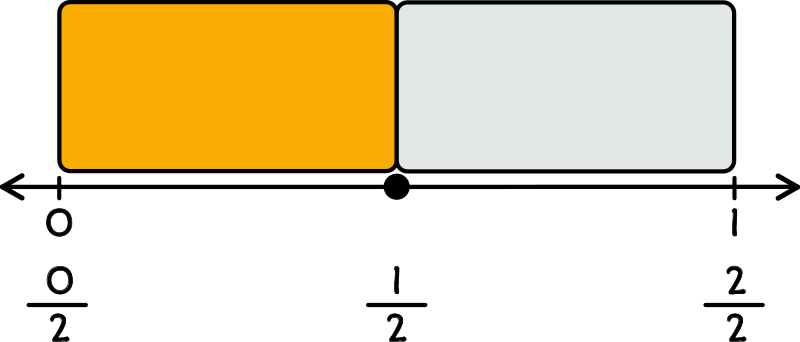Let’s Learn!
How do you partition a number line to record fractions?
Goal:
Goal:
This is a section of Caleb’s newest gingerbread house. He has decorated 23 of this square. 23 is a fraction of a whole. A fraction names a certain number of parts out of the total number of parts of a whole. Let’s record 23 on a number line!

Draw an empty rectangle.

Partition the rectangle, and color it in to represent 23. That means the rectangle should be partitioned into 3 equal parts with 2 of the parts colored in.

Create the number line. A number line is a straight line with arrows at both ends and numbers equally spaced out. Draw a horizontal line right underneath your rectangle with arrows at both ends of the line, just like this:

Label the number line. 23 is between 0 and 1, because we can see that the full rectangle is not shaded. That means the number line will begin at 0 and end at 1.

Label the number line with fractions. First, draw a line segment where each partition of the rectangle meets the number line.

The rectangle is partitioned into 3 equal parts, so the denominator is 3. Next, label each segment with the denominator, even where the 0 and 1 are.

Rectangle partitioned into 3 equal parts. With 2 parts filled in. Number line underneath from 0 to 1. Markers for each partition. Number line is labeled 3 for each marker.
Finally, label the numerators. Remember to start at 03, or 0, and end at 33, or 1.

Rectangle partitioned into 3 equal parts. With 2 parts filled in. Number line underneath from 0 to 1. Markers for each partition. Number line is labeled 03, 13, 23, 33, 43.
Caleb needs to record 23 on the number line. We record this fraction by drawing a dot above 23.

Rectangle partitioned into 3 equal parts. With 2 parts filled in. Number line underneath from 0 to 1. Markers for each partition. Number line is labeled 03, 13, 23, 33, 43. Dot on 23.
Great job! We can remove the rectangle so we can see just the number line. This is 23 on a number line!

Number line is labeled 03, 13, 23, 33, 43. Dot on 23.
Let’s look at more fractions! Click on each fraction below to see it recorded on a number line.
12

Rectangle partitioned into 2 parts with 1 part filled in. Number line from 0 to 1 with markers for each part. Markers are labeled 02, 12, 22.
13

Rectangle partitioned into 3 parts with 1 part filled in. Number line from 0 to 1 with markers for each part. Markers are labeled 03, 13, 23, 33.
14

Rectangle partitioned into 4 parts with 1 part filled in. Number line from 0 to 1 with markers for each part. Markers are labeled 04, 14, 24, 34, 44.
16

Rectangle partitioned into 6 parts with 1 part filled in. Number line from 0 to 1 with markers for each part. Markers are labeled 06, 16, 26, 36, 46, 56, 66.
18

Rectangle partitioned into 8 parts with 1 part filled in. Number line from 0 to 1 with markers for each part. Markers are labeled 08, 18, 28, 38, 48, 58, 68, 78, 88.
